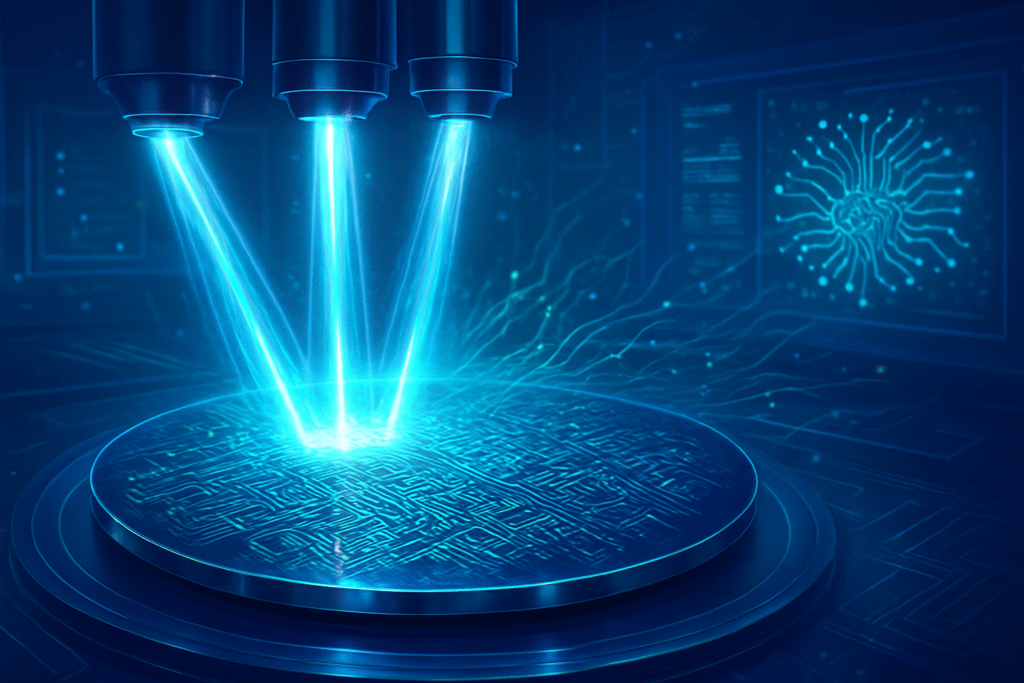
Substrate, a San Francisco-based company, is poised to revolutionize semiconductor manufacturing with its innovative X-ray lithography system, a groundbreaking technology that leverages particle accelerators to produce chips with unprecedented precision and efficiency. Moving beyond conventional laser-based methods, this novel approach utilizes powerful X-ray light to etch intricate patterns onto silicon wafers, directly challenging the dominance of industry giants like ASML (AMS: ASML) and TSMC (NYSE: TSM) in high-end chip production. The immediate significance of Substrate's technology lies in its potential to dramatically reduce the cost of advanced chip fabrication, particularly for demanding applications such as artificial intelligence, while simultaneously aiming to re-establish the United States as a leader in semiconductor manufacturing.
Technical Deep Dive: Unpacking Substrate's X-Ray Advantage
Substrate's X-ray lithography system is founded on a novel method that harnesses particle accelerators to generate exceptionally bright X-ray beams, described as "billions of times brighter than the sun." This advanced light source is integrated into a new, vertically integrated foundry model, utilizing a "completely new optical and high-speed mechanical system." The company claims its system can achieve resolutions equivalent to the 2 nm semiconductor node, with capabilities to push "well beyond," having demonstrated the ability to print random vias with a 30 nm center-to-center pitch and high pattern fidelity for random logic contact arrays with 12 nm critical dimensions and 13 nm tip-to-tip spacing. These results are touted as comparable to, or even better than, those produced by ASML's most advanced High Numerical Aperture (NA) EUV machines.
A key differentiator from existing Extreme Ultraviolet (EUV) lithography, currently dominated by ASML, is Substrate's approach to light source and wavelength. While EUV uses 13.5 nm extreme ultraviolet light generated from a laser-pulsed tin plasma, Substrate employs shorter-wavelength X-rays, enabling narrower beams. Critically, Substrate's technology eliminates the need for multi-patterning, a complex and costly technique often required in EUV to create features beyond optical limits. This simplification is central to Substrate's promise of a "lower cost, less complex, more capable, and faster to build" system, projecting an order of magnitude reduction in leading-edge silicon wafer costs, targeting $10,000 per wafer by the end of the decade compared to the current $100,000.
The integration of machine learning into Substrate's design and operational processes further streamlines development, compressing problem-solving times from years to days. However, despite successful demonstrations at US National Laboratories, the semiconductor industry has met Substrate's ambitious claims with widespread skepticism. Experts question the feasibility of scaling this precision across large wafers at high speeds for high-volume manufacturing within the company's stated three-year timeframe for mass production by 2028. The immense capital intensity and the decades of perfected technology by incumbents like ASML and TSMC (NYSE: TSM) present formidable challenges.
Industry Tremors: Reshaping the AI and Tech Landscape
Substrate's emergence presents a potentially significant disruption to the semiconductor industry, with far-reaching implications for AI companies, tech giants, and startups. If successful, its X-ray lithography could drastically reduce the capital expenditure required to build advanced semiconductor manufacturing facilities, thereby lowering the barrier to entry for new chipmakers and potentially allowing smaller players to establish advanced fabrication capabilities currently monopolized by a few giants. This could lead to a more diversified and resilient global semiconductor manufacturing ecosystem, a goal that aligns with national security interests, particularly for the United States.
For AI companies, such as OpenAI and DeepMind, and tech giants like Alphabet (NASDAQ: GOOGL), Microsoft (NASDAQ: MSFT), Amazon (NASDAQ: AMZN), Meta Platforms (NASDAQ: META), Apple (NASDAQ: AAPL), NVIDIA (NASDAQ: NVDA), Intel (NASDAQ: INTC), and Advanced Micro Devices (NASDAQ: AMD), the implications are transformative. More powerful and energy-efficient chips, enabled by smaller nodes, would directly translate to faster training of large language models and deep neural networks, and more efficient AI inference. This could accelerate AI research and development, reduce operational costs for AI accelerators, and unlock entirely new AI applications in areas like autonomous systems, advanced robotics, and highly localized edge AI. Companies already designing their own AI-specific chips, such as Google with its TPUs, could leverage Substrate's technology to produce these chips at lower costs and with even higher performance.
The competitive landscape would be significantly altered. ASML's (AMS: ASML) dominant position in EUV lithography could be challenged, forcing them to accelerate innovation or reduce costs. Leading foundries like TSMC (NYSE: TSM) would face direct competition in advanced node manufacturing. Intel (NASDAQ: INTC), with its renewed foundry ambitions, could either partner with Substrate or see it as a direct competitor. Furthermore, the democratization of advanced nodes, if Substrate's technology makes them more accessible and affordable, could level the playing field for smaller AI labs and startups against resource-rich tech giants. Early adopters of Substrate's technology could gain a significant competitive edge in performance and cost for their AI hardware, potentially accelerating hardware refresh cycles and enabling entirely new product categories.
Wider Significance: A New Dawn for Moore's Law and Geopolitics
Substrate's X-ray lithography technology represents a significant potential shift in advanced semiconductor manufacturing, with profound implications for the artificial intelligence (AI) landscape, global supply chains, and geopolitical dynamics. The escalating cost of advanced chip fabrication, with projections of advanced fabs costing $50 billion by 2030 and single wafer production reaching $100,000, makes Substrate's promise of drastically reduced costs particularly appealing. This could effectively extend Moore's Law, pushing the limits of transistor density and efficiency.
In the broader AI landscape, hardware capabilities increasingly bottleneck development. Substrate's ability to produce smaller, denser, and more energy-efficient transistors directly addresses the exponential demand for more powerful, efficient, and specialized AI chips. This foundational manufacturing capability could enable the next generation of AI chips, moving beyond current EUV limitations and accelerating the development and deployment of sophisticated AI systems across various industries. The technical advancements, including the use of particle accelerators and the elimination of multi-patterning, could lead to higher transistor density and improved power efficiency crucial for advanced AI chips.
While the potential for economic impact – a drastic reduction in chip manufacturing costs – is immense, concerns persist regarding technical verification and scaling. ASML's (AMS: ASML) EUV technology took decades and billions of dollars to reach maturity; Substrate's ability to achieve comparable reliability, throughput, and yield rates in a relatively short timeframe remains a major hurdle. However, if successful, this could be seen as a breakthrough in manufacturing foundational AI hardware components, much like the development of powerful GPUs enabled deep learning. It aims to address the growing "hardware crisis" in AI, where the demand for silicon outstrips current efficient production capabilities.
Geopolitically, Substrate's mission to "return the United States to dominance in semiconductor fabrication" and reduce reliance on foreign supply chains is highly strategic. This aligns with U.S. government initiatives like the CHIPS and Science Act. With investors including the Central Intelligence Agency-backed nonprofit firm In-Q-Tel, the strategic importance of advanced chip manufacturing for national security is clear. Success for Substrate would challenge the near-monopoly of ASML and TSMC (NYSE: TSM), diversifying the global semiconductor supply chain and serving as a critical component in the geopolitical competition for technological supremacy, particularly with China, which is also heavily investing in domestic semiconductor self-sufficiency.
Future Horizons: Unlocking New AI Frontiers
In the near-term, Substrate aims for mass production of advanced chips using its X-ray lithography technology by 2028, with a core objective to reduce the cost of leading-edge silicon wafers from an estimated $100,000 to approximately $10,000 by the end of the decade. This cost reduction is expected to make advanced chip design and manufacturing accessible to a broader range of companies. Long-term, Substrate envisions continuously pushing Moore's Law, with broader X-ray lithography advancements focusing on brighter and more stable X-ray sources, improved mask technology, and sophisticated alignment systems. Soft X-ray interference lithography, in particular, shows potential for achieving sub-10nm resolution and fabricating high aspect ratio 3D micro/nanostructures.
The potential applications and use cases are vast. Beyond advanced semiconductor manufacturing for AI, high-performance computing, and robotics, XRL is highly suitable for Micro-Electro-Mechanical Systems (MEMS) and microfluidic systems. It could also be instrumental in creating next-generation displays, such as ultra-detailed, miniature displays for smart glasses and AR headsets. Advanced optics, medical imaging, and novel material synthesis and processing are also on the horizon.
However, significant challenges remain for widespread adoption. Historically, high costs of X-ray lithography equipment and materials have been deterrents, though Substrate's business model directly addresses this. Mask technology limitations, the need for specialized X-ray sources (which Substrate aims to overcome with its particle accelerators), throughput issues, and the engineering challenge of maintaining a precise proximity gap between mask and wafer all need to be robustly addressed for commercial viability at scale.
Experts predict a robust future for the X-ray lithography equipment market, projecting a compound annual growth rate (CAGR) of 8.5% from 2025 to 2033, with the market value exceeding $6.5 billion by 2033. Soft X-ray lithography is increasingly positioned as a "Beyond EUV" challenger to Hyper-NA EUV, with Substrate's strategy directly reflecting this. While XRL may not entirely replace EUV, its shorter wavelength provides a "resolution reserve" for future technological nodes, ensuring its relevance for developing advanced chip architectures and finding crucial applications in specific niches where its unique advantages are paramount.
A New Chapter in Chipmaking: The Road Ahead
Substrate's innovative laser-based technology for semiconductor manufacturing represents a pivotal moment in the ongoing quest for more powerful and efficient computing. By leveraging X-ray lithography and a vertically integrated foundry model, the company aims to drastically reduce the cost and complexity of advanced chip production, challenging the established order dominated by ASML (AMS: ASML) and TSMC (NYSE: TSM). If successful, this breakthrough promises to accelerate AI development, democratize access to cutting-edge hardware, and reshape global supply chains, with significant geopolitical implications for technological leadership.
The significance of this development in AI history cannot be overstated. Just as GPUs enabled the deep learning revolution, and specialized AI accelerators further optimized compute, Substrate's technology could provide the foundational manufacturing leap needed for the next generation of AI. It addresses the critical hardware bottleneck and escalating costs that threaten to slow AI's progress. While skepticism abounds regarding the immense technical and scaling challenges, the potential rewards—cheaper, denser, and more efficient chips—are too substantial to ignore.
In the coming weeks and months, industry observers will be watching for further independent verification of Substrate's capabilities at scale, details on its manufacturing partnerships, and the timeline for its projected mass production by 2028. The competition between this novel X-ray approach and the continued advancements in EUV lithography will define the future of advanced chipmaking, ultimately dictating the pace of innovation across the entire technology landscape, particularly in the rapidly evolving field of artificial intelligence. The race to build the next generation of AI is intrinsically linked to the ability to produce the chips that power it, and Substrate is betting on X-rays to lead the way.
This content is intended for informational purposes only and represents analysis of current AI developments.
TokenRing AI delivers enterprise-grade solutions for multi-agent AI workflow orchestration, AI-powered development tools, and seamless remote collaboration platforms.
For more information, visit https://www.tokenring.ai/.





